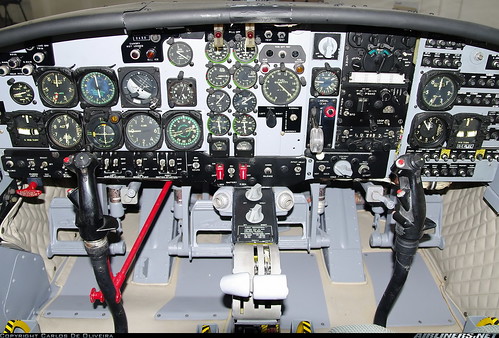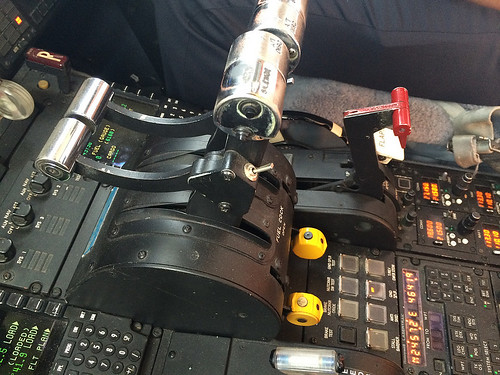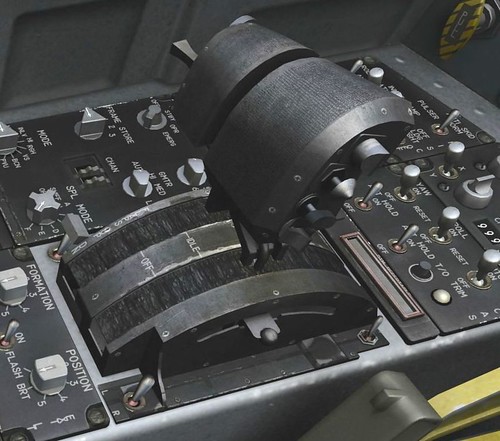I’ve been following news of the May 31 Gulfstream IV crash at Hanscomb Field in Bedford, Massachusetts. This was the executive jet carrying some VIP or other that reached a high speed on takeoff roll and then ran off the end of the runway and into a ditch, bursting into flame and killing everyone aboard. Preliminary NTSB reports are focusing on a mechanical safety system called the gust lock.
The only airplane I ever flew that had a mechanical gust lock was the T-37. It was a bar you swung out from below the control panel and pinned to the left control stick, locking the stick and rudder pedals in the neutral position. Since the external flight controls were connected directly to the stick and rudder pedals by cables, they were locked in a neutral position as well. You engaged the gust lock whenever parking the airplane to keep wind from moving the external control surfaces and damaging them. The locking bar was painted bright red so you couldn’t miss it during your preflight checks, and of course if you did somehow miss it you’d know right away when you did your flight control check and realized you couldn’t move the stick and rudders.

The Gulfstream’s gust lock is pretty much the same from all I can determine. It’s more sophisticated in that in addition to locking the flight controls it also locks the throttles so that they can’t be advanced much beyond idle. It’s probably safe to assume it’s either painted red or has a red “remove before flight” banner hanging from it … I did a Google search for a photo of it but couldn’t find one.
The Gulfstream reached a peak speed of 165 knots (190 mph) on takeoff roll but never rotated. Flight recorder data shows the airplane’s elevators never moved during ground ops or takeoff roll. This indicates that the controls were locked. The most likely culprit is the gust lock. The recorder also shows that the pilots didn’t perform a flight control check before attempting to take off.
But things are always more complicated, aren’t they? Obviously the pilots were able to advance the throttles to full thrust for takeoff, and they shouldn’t have been able to with the gust lock engaged. Also, examination of the cockpit wreckage showed that the gust lock was not engaged, though it’s possible the pilots disengaged it during takeoff roll, right after they realized the controls were jammed (they’re heard talking about flight controls on the cockpit voice recorder, but the NTSB hasn’t yet released a transcript). There’s also some discrepancy with the flaps (the flaps were found in the 20° position but the cockpit flap lever was in the 10° position), but flap position would not have had much impact on a normal takeoff, so that’s probably just a side issue.
Perhaps the gust lock was partially engaged, locking the flight controls but not the throttles. Perhaps the pilots realized the problem on takeoff when they tried to pull the yoke back and found it jammed, then disengaged the gust lock about the same time they decided to abort the takeoff. Maybe it wasn’t the gust lock at all but some sort of flight control disconnect, where the yoke moved back but the elevator didn’t respond. Unknown at this time, although the gust lock looks mighty central to any scenario.
But don’t let talk of that mechanical gust lock cloud the issue. The pilots clearly were negligent during their preflight checks. Had they performed a flight control check before taxiing, as the checklist requires, they would have discovered the problem. Clue number one would have been their inability to move the yoke and rudder pedals. If it wasn’t the gust lock but some kind of flight control malfunction, they should have discovered it during their pre-taxi flight control check when they noticed the rudder, elevator, and ailerons not responding to cockpit control movements. The fact that the flight recorder shows no indication of a control check suggests the possibility the pilots blew off the checklist altogether, which, as sins go, is somewhere above cardinal, maybe even approaching papal. This is a pilot-caused accident. A really stupid pilot-caused accident … but then aren’t most of them?
Update (6/27/14): I found a photo of the Gulfstream IV gust lock on a professional pilot forum.

The gust lock is the red T-handle just behind the throttles. It’s shown in the engaged (locked) position. The throttles are partially advanced; according to the poster who sent the photo, this is as far as they can be advanced with the gust lock on.
In all the airplanes I’ve flown, you steer the nose wheel on the ground with the rudder pedals. I know that large transport aircraft have a separate hand control for nose wheel steering. I don’t know what the Gulfstream has. If the pilots had to steer their plane down the taxiway with the rudder pedals, they’d have known the gust lock was engaged the second they rolled out of the chocks, because they wouldn’t have been able to move the pedals. If, however, they were steering with a separate hand control, one that wasn’t affected by the gust lock, they probably wouldn’t have noticed.
If the gust lock was engaged and the throttles couldn’t be shoved all the way forward for takeoff, how did they manage to get up to 165 knots on takeoff roll? Also, you start to feel the air moving over the rudder, elevators, and ailerons between 50 and 60 knots on takeoff. If there was the least bit of crosswind (and there almost always is) the airplane would start to steer into the wind, turning away from runway centerline, and the pilots would start correcting with rudder and ailerons. If the flight controls were really locked, they should have been aware of the problem very early on takeoff roll, with plenty of time to reject the takeoff and abort. Damn, the questions keep coming. Maybe this preliminary NTSB report is too preliminary!
——————–
And now for something completely different … among the materials that go into the making of the F-15 Eagle fighter are horse parts. Can you guess what they are and what they are used for?

See the bristles in the slots below the throttles? They’re horse hair, nice and stiff, and they keep foreign objects from dropping down into the throttle quadrant and jamming the works. Horse hair is probably used in other aircraft as well … it seems to be the ideal material for that particular task.
Seems to me that one could design a gust lock just soft enough that a terrified pilot would be strong enough to fly the plane for a few minutes, although I suppose one that kept the engines from starting might do as well or better. Just how strong does a gust lock have to be? Maybe some kind of shear pin?